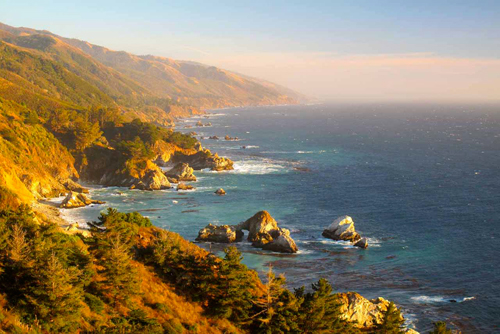Monterey County’s historical heritage is rich and diverse. Prime examples of historic sites survive from each of the major periods of California’s and the history of Big Sur. Historical settlement of the Big Sur coast was initiated by the Mexican Government in the late 18th century with the bestowal of two land grants-the 8,949 acre Rancho El Sur (between the Little Sur River and what is now called Cooper Point) and Rancho San Jose y Sur Chiquito, an 8,876 acre grant, bounded on the north by the Carmel River and on the south by Palo Colorado Canyon.
With the United States occupation, unappropriated public lands in California became available to settlers in parcels of 160 acres. Big Sur was initially settled by a number of homesteaders whose names are now borne by well known topographic and natural features in Big Sur (e.g., the Pfeiffers, Carlie Bixby and Jim Anderson).
In the history of Big Sur the development of a tan bark industry in the mid-1870’s led to the construction of several landings along the Coast. These landings were used for loading the bark (used in the manufacture of tannic acid), as well as for shipping redwood lumber. Among them was Godfrey Notley’s Landing, near the mouth of the Palo Colorado Canyon, around which a thriving village sprang up. Jim Anderson also had a landing and there was another at the mouth of the Big Sur River. Perhaps the most spectacular was Partington Landing. The Rockland Cement Company chose Limekiln Canyon as its headquarters in the 1880’s in order to exploit a rich deposit of calcareous rock discovered in the vicinity of the canyon. Schooners began to regularly frequent Rockland Landing to load limestone bricks and deliver supplies. With the demise of the liming operation, the days of industrial enterprise along the Big Sur coast came to an abrupt halt.
The discovery of gold near the head of Alder Creek led to the Big Sur Gold Rush of the 1880’s. The Los Burros Mining District sprang into being with three stamp mills and a boomtown named Manchester mushroomed on Alder Creek. In its heyday, Manchester boasted four stores, a restaurant, five saloons, a dance hall and a hotel. By 1895 the boom had begun to fade.
As the 19th century drew to a close, more settlers came to live on the south coast. The two sons of one of the original homesteaders, Bill Post, each homesteaded 160 acres, while various relatives acquired tracts totaling another 640 acres. Their land stretches as far south as the site of the present-day Nepenthe Restaurant. The ranchhouse still stands on Highway 1 at the top of what is now called “Post Grade”. Big Sur’s original post office and its second schoolhouse were built on the Post Ranch.
The 20th century saw the emergence of recreation-oriented commercial development along the Big Sur Coast. For decades, the Big Sur country had been attracting hunters and fishermen. The start of the resort business began with the Pfeiffer Ranch Resort, which catered to these sportsmen. The Hotel Idlewild, located on the banks of the Little Sur River, soon rivaled the Pfeiffer Ranch for its business.
The one deterrent to the development of the south coast as a mecca for tourists as well as sportsmen, was the hazardous road that had to be closed part of the year. The concept of a year-round scenic highway originated with Dr. John Roberts, the founder of the City of Seaside.
Many of the original settlers were enraged by the devastation resulting from the highway construction. Machinery blasted through the great cliffs, scarring granite promontories, defiling canyons and waterfalls with debris. On June 27, 1937, the highway was completed at a cost of approximately $8,000,000. A way of life had ended and a new era began for the beautiful country.
The process of ensuring the long-term protection and unique history of Big Sur and its exclusive coastline was initiated by John Pfeiffer in 1934 when he sold 706 acres to the State for the nucleus of the 822 acre Pfeiffer Big Sur State Park. The Lathrop Browns, who purchased Saddle Rock Ranch, later donated 1,700 acres which now constitutes Julia Pfeiffer Burns State Park. The 21 acre John Little State Park, originally part of the Slate property sold to Milton Little, was donated by Elizabeth Livermore. Francis Molera, granddaughter of Juan Bautista Roger Cooper, placed 2,000 acres in trust for Andrew Molera State Park. The generosity of these pioneering families has been a lasting contribution to the preservation and history of Big Sur and the people of Monterey County and the State.



Greg Laskaris says:
Thanks for writing and posting all this. Lots of rich details! I am looking for any information (articles, books, etc.) about the construction of Hwy. 1 along the Big Sur coast because an old friend of mine walked from San Francisco to Santa Barbara in about 1920 or so. He had heard about plans to built the road, and felt that the coast would somehow never be the quite the same after its construction. He told me that it had been originally planned as a military road since the Army felt it needed access to all possible points along the coast, and that no one had expected it would take so long to build.
There appears to have only been a wagon road then, but he told me he found what locals said were a few remaining Indian trails.
makayla says:
wow id love to hear more about his journey! did he follow the road or make his own path? and like how did he survive w enough food? so many questions, so interesting